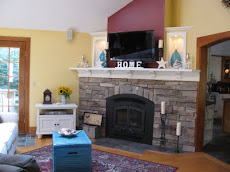
To those of you who have been gardening and growing vegetables for awhile this is no big deal, but to me it was something I've been dreaming about for the past year (silly I know... some women dream of the finer things in life while all I wanted was a decent patch of fertile soil). I got my first taste of vegetable gardening last year when I interplanted some veggies with perennials on our small plot of land. It didn't take much to hook us on home grown vegetables -- one taste of a sweet pea and a crisp cool cucumber was all it took. Although we got a decent harvest from our haphazard approach to gardening I knew that things could be so much better if we did a little planning and had a little better soil. So, after many months of research by looking at blogs, reading magazines and books, and talking to anyone whoever grew so much as a a tomato plant I came up with my own version of a raised bed.
The basic is a traditional raised bed. The frame was easy to build (at least it was easy for Ellie Mae's Dad - he owns a home improvement business and is a woodworking craftsman so building a square box frame was as easy for him as it is for a fine chef to make a grilled cheese sandwich). The hard part was figuring out where we were going to install the bed, how big it would be, what type of soil it would contain, and what kinds of vegetables we would plant in it.
Stakes for the bed all lined up and ready to go.

2" x 8" pine boards ready for framing (No treated lumber. Would have used cedar, but it's not in the budget this year. We'll have to replace these pine boards in a few years.)

A neat way to stack up the boards so they can be easily drilled for the screw holes - hubby knows all the tricks!

Holes all drilled.

The stake installed.

The finished product. Isn't she beautiful!

My first point of reference was Mel Bartholomew's All New Square Foot Gardening.

After reading this book the ideas in it made tons of sense, but he lost me when he recommends not using the soil that is already in the ground. Amending existing soil as long as it's not contaminated is sustainable gardening, while ignoring it completely just doesn't sit well with me. True it may take a little longer to get the soil to an optimal level when starting with the land beneath your feet, but building upon something that is already there and watching the wonders of Mother Nature transform it - worms and all - is a small miracle to me. Of course, it you don't have this option and want to garden where no soil exists than using Mel's Mix makes perfect sense.
The second book I read was The Vegetable Gardener's Bible by Edward C. Smith.

Here the author advocates the W-O-R-D system, which is Wide Rows, Organic Methods, Raised Beds, and Deep Soil. In my opinion the Smith method is more sustainable, but does lacks some of the quick fix ideas that Bartholomew's book provides. The Smith book is a comprehensive nuts and bolts approach to vegetable gardening that you can use as a foundation for learning, while the Bartholomew book will get a new gardener out of the gate and running in no time at all.

In the end I combined what I thought was the best advice from both books. We built a traditional raised bed of 4x8 feet, but instead of filling it with Mel's Mix we used the existing soil and amended it with topsoil, manure, compost, and peat moss. We then sprinkled on some lime since the home soil test indicated that we needed to neutralize some of the acid, and tilled the entire mixture together.

How much we used of each I really couldn't say (I know I should have measured and recorded what we used), but my approach to gardening is similar to the way I cook - I do it by feel using a little of this and little of that until it looks and feels right. The Vegetable Gardener's Bible helped me more in that respect since instead of giving me recipe for creating the perfect planting mix he outlines the basics of how to tell if you have a good soil. I certainly don't know if I got the mix right - as a matter I know that I didn't (it's still too sandy and rocky) and I realize that it can take years and years to work a good soil - but, I think we made a good foundation that we can build upon. Like everything else about gardening it's a process and patience certainly is a virtue.

The plan I drew up calls for 5 - 4'x8' beds (3 will go along the side yard fence and 2 near a rhodie tree). The area doesn't get as much sun as I'd like (only about 5-6 hours of full sun a day - I'd prefer 8 hours for veggie garden), but it's the sunniest place on our property outside of the front yard perennial bed. Unfortunately cutting down trees is not an option since they are on our neighbor's property - do you think they'd notice a masked bandit at night cutting down a few trees?

So with the challenges of a partially sun plot and some Massachusetts south coast sandy soil we embark on a new vegetable gardening season. We've got one bed completely built, installed, and filled with 4 more to go. At least in New England it's still early in the season - like everything we do it's taking longer than I would like but that's how we roll. Onward and upward as we say cheers to raising our bed!





















































.JPG)




.JPG)












11 comments:
I am glad your dream is coming true! The new bed is beautiful. I don't vegie garden, but I am earning so much form all of you all! gail
I'd love to try more raised beds. We only have one now, which is where the lettuce usually ends up. I've just started reading "The Backyard Homestead", which shows some great plans on how to get a garden in small spaces. Looks like you are off to a fantastic start. Your dirt looks delish, BTW!
Yeah! You are now among the many who love to raised bed garden! I hope you enjoy it as much as I have. Great way to keep up on the weeding too!
Heather
It looks good Jackie. You did the right thing amending your soil and working it all up. No need to measure, gardeners just know when soil is right and I think your veggies will be happy. You might want to soil test the beds this fall though. More than likely the pH is perfect, but to be sure get a soil test.
Your new veggie bed look great. You're right about gardeners being a little odd. A load of composted manure or a nice pair of pruners would make me happier than more traditional gifts like clothes;)
Marnie
Great looking veggie bed! I too dream of many raised beds in the garden and so far I have 2.
Very good Jackie! I agree with Tina. It will be a good idea to soil test this fall, with an eye towards the needs of the plants you will be raising next year. Good luck to you. I have a wet spot, where I'd like to have a raised bed or two or three. Keep an eye on it--if it is gone you may have to go to Ohio to look for it!!
That looks fantastic, can't wait to see stuff growing in there! - Elaine
It looks great! You will love having the raised beds and I bet you have lots of yummy veggies this summer. Have fun planting :)
That looks like a great raised bed, Jackie...rich and deep new soil..your plants will all thrive!! Have fun planting :)
Good luck with your new bed. Looks like you have done all the right preparations, so anything you put in should grow well.
Jan
Always Growing
Post a Comment